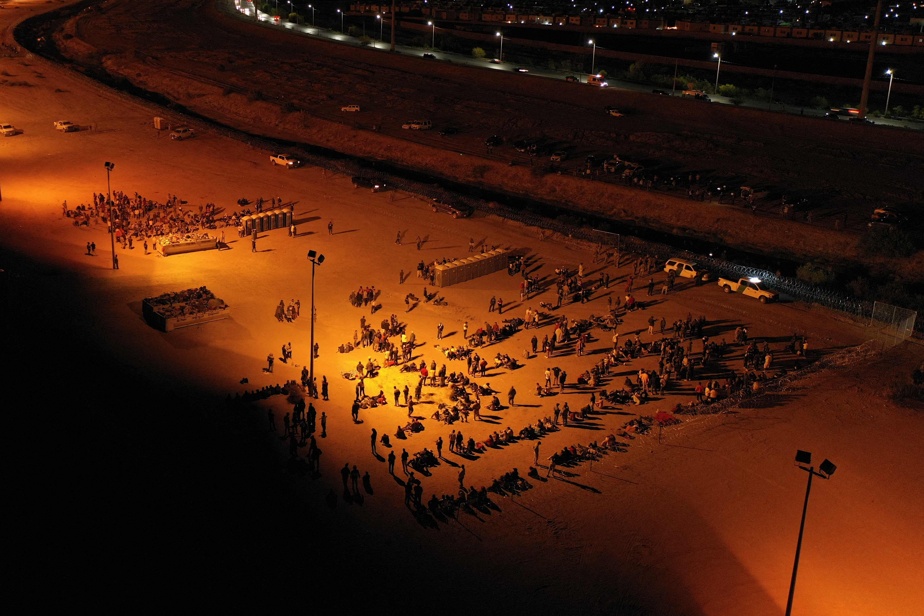(El Paso) Uncertainty reigns on Friday at the United States border with Mexico, after the expiration of a measure that had blocked access to American territory for three years, confusing many migrants and raising fears a “chaotic” influx to the authorities.
This measure, “Title 42” aimed at countering the pandemic, expired at 11:59 p.m. Thursday (11:59 p.m. EST]Friday).
Faced with Republicans who demanded its maintenance and denounced a potential “invasion”, the government of Democratic President Joe Biden, again a candidate for 2024, recalled that new restrictions on the right of asylum have been adopted.
“I want to be very clear: our border is not wide open. People crossing our border illegally and without a legal basis to stay will be immediately […] expelled,” Homeland Security Secretary Alejandro Mayorkas said.
However, “we are lucid about the challenges that we are likely to face in the days and weeks to come and we are ready to respond to them”, he added, noting that “a high number of arrivals” had already been observed “in certain sectors”.
Mr. Biden himself recently claimed that the situation would be “chaotic for a while”.
The federal state has prepared, with more than 24,000 agents and police forces at the border in addition to 4,000 soldiers.
Restrictions on asylum
Some migrants rushed across the border some 3,000km before ‘Title 42’ was lifted to seek asylum, fearing the change in rules would prevent them from doing so for five years.
“Title 42”, supposed to limit the spread of COVID-19, gave the possibility to American authorities to immediately return all migrants entering the country, including asylum seekers. In three years, it has been used 2.8 million times.
New asylum restrictions, finalized by the Departments of Justice and Homeland Security, immediately went into effect Thursday evening.
Before presenting themselves at the border, asylum seekers, except unaccompanied minors, must now have obtained an appointment on a telephone application centralizing requests, “CBP One”, or have been refused asylum in one of the countries crossed.
Otherwise, their request will be presumed illegitimate and they may be subject to an accelerated deportation procedure, prohibiting them from entering American soil for five years.
Faced with changes in migratory systems, rumors spread by smugglers and a complex online procedure, migrants who pile up in northern Mexico bear witness to a puzzle, amplified by frequent bugs in the application.
Tears and frustrations
In Brownsville, a town in Texas bordering Mexico, some 22,000 people are camping on the Mexican side of the border, Republican Senator Ted Cruz told reporters. He said he was “angry” at a “deliberate” decision by the Democratic executive “to open the border to what is nothing less than an invasion”.
Republican Kansas Sen. Roger Marshall told Fox News the situation at the border was a “disaster.”
“The number one threat to our national security is right here in southern Texas all the way to Arizona,” he said, “it’s not the America I grew up in.”
California Democratic Representative Mike Levin accused Republicans of playing “political football” with the difficulties of the immigration system and of seeking to “score points rather than actually work to fix it”.
In Brownsville, AFP saw dozens of police vehicles deployed on the American side of the bridge that connects the city to Matamoros on the Mexican side.
A little further on, earthmoving equipment was visible with employees preparing to install barbed wire.
In the streets of the city, Gabriel Landaeta, 22, is one of those who sleep outside. “If someone ever makes a documentary, say that good-hearted Venezuelans came here in search of happiness,” he says.
With their bad English, he and other migrants try to find out. “Title 42 is over,” a policeman tells them.
In El Paso (Texas), hundreds of people who entered on Thursday had their files processed and were able to file an asylum application. But many others were detained by border guards, among whom there seemed to be some confusion. “We don’t know,” replied one of them when asked what will happen to the migrants who were able to get through.
On the Mexican side, in Ciudad Juárez, Agustin Sortomi explains that he himself, his wife and their two children have tried several times to surrender to the American authorities, but have each time been refused.
“A lot of people are already coming back saying they’re not letting anyone through. I don’t know what to do,” he said. “We did not achieve our dream. God only knows when we will.”
